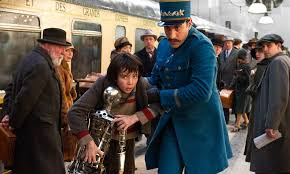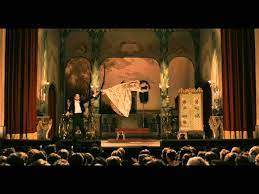Hugo is a 2011 American adventure drama film directed and produced by Martin Scorsese, and adapted for the screen by John Logan. Based on Brian Selznick's 2007 book The Invention of Hugo Cabret, it tells the story of a boy who lives alone in the Gare Montparnasse railway station in Paris in the 1930s, only to become embroiled in a mystery surrounding his late father's automaton and the pioneering filmmaker Georges Méliès.
Hugo is Scorsese's first film shot in 3D, about which the filmmaker remarked, "I found 3D to be really interesting, because the actors were more upfront emotionally. Their slightest move, their slightest intention is picked up much more precisely." The film was released in the United States on November 23, 2011.
Hugo received 11 Academy Award nominations (including Best Picture), more than any other film that year, winning five: Best Cinematography, Best Art Direction, Best Sound Mixing, Best Sound Editing, and Best Visual Effects. It was also nominated for eight BAFTAs, including a Best Director nomination (for Scorsese) and winning two, and was nominated for three Golden Globe awards, earning Scorsese his third Golden Globe Award for Best Director. Despite receiving acclaim from critics, the film was considered a box office failure, grossing just $185 million against its estimated $150 million budget.
Plot
In 1931 Paris, 12-year-old Hugo Cabret lives with his widowed father, a clockmaker who works at a museum. Hugo's father finds a broken automaton - a mechanical man created to write with a pen. He and Hugo try to repair it, documenting their work in a notebook. When his father dies in a fire, Hugo goes to live with his father's alcoholic brother, Uncle Claude, who maintains the clocks at Gare Montparnasse railway station. When Claude goes missing, Hugo continues maintaining the clocks, fearing that the Station Inspector named Gustave Dasté will send him away if Claude's absence is discovered. Hugo attempts to repair the automaton with stolen parts, believing it contains a message from his father, but the machine requires a heart-shaped key.
Hugo is caught stealing parts from a toy store, and the owner, Georges, takes his notebook, threatening to destroy it. Georges' goddaughter Isabelle suggests that Hugo confront Georges and demand it back. Georges proposes that Hugo work at his toy store as recompense, and after some time he might return the notebook. Hugo accepts and commences work, in addition to his job maintaining the clocks. Isabelle and Hugo become fast friends, and Hugo is astonished to see she wears a heart-shaped key, given to her by Georges. Hugo shows her the automaton, which they activate with the key. It draws a scene from the 1902 film A Trip to the Moon, once described to Hugo by his father. Isabelle identifies the drawing's signature as that of "Georges Méliès" - her godfather. She sneaks Hugo into her home, where they find a hidden cache of drawings, but they are discovered by Georges.
Several days later, at the Film Academy Library, Hugo and Isabelle find a book about the history of cinema that praises Méliès' contributions. They meet the book's author, René Tabard, a film expert who is surprised to hear Méliès is alive, as he disappeared after World War I along with the copies of his films. Excited at the chance to meet Méliès again, René agrees to meet Isabelle and Hugo at Georges' home to show his copy of A Trip to the Moon.
Finding the heart-shaped key on the station railway tracks, Hugo drops down to the track to retrieve it, and is run over by an out-of-control train that smashes through the station. He wakes up from the nightmare, but hears an ominous ticking emanating from himself, and discovers he has been turned into the automaton. Hugo wakes up again: it was only another nightmare.
At Georges’ home, his wife Jeanne allows them in after René recognises her as Jeanne d'Alcy, an actress in many of Méliès' films. They play the film, waking Georges, who is finally convinced to cherish his accomplishments rather than regret his lost dreams. Georges recounts that, as a stage magician, he was fascinated by motion pictures and used film to create imaginative works through his Star Film Company. Forced into bankruptcy after the war, he closed his studio and sold his films. He laments that even an automaton he built and donated to a museum was lost; Hugo realizes it is the one he has repaired.
Hugo races to the station to retrieve the automaton but is caught by Gustave, who has learned of Claude's death. Gustave threatens to take Hugo to the orphanage. Hugo runs away and manages to evade Gustave by hiding on the outer face of the clock tower, precariously balancing hundreds of feet above the ground. After climbing back down, Hugo races to escape the station but drops the automaton on the tracks. He jumps down to retrieve it and is almost run over by a train, but Gustave saves him and the automaton. Georges arrives and tells Gustave, "This boy belongs to me."
Sometime later, Georges is named a professor at the Film Academy, and is paid tribute through a showcase of his films recovered by René. Hugo and his new family celebrate at the apartment, and Isabelle begins to write down Hugo's own story.
Production
Pre-production
GK Films acquired the screen rights to The Invention of Hugo Cabret shortly after the book was published in 2007. Initially, Chris Wedge was signed in to direct the adaptation and John Logan was contracted to write the screenplay. The film was initially titled Hugo Cabret. Several actors were hired, including Ben Kingsley, Sacha Baron Cohen, Asa Butterfield, Chloë Grace Moretz, and Helen McCrory. Jude Law, Ray Winstone, Christopher Lee, Frances de la Tour, and Richard Griffiths later joined the project. Hugo was originally budgeted at $100 million, but ran over with a final budget between $156 million and $170 million. In February 2012, Graham King summed up his experience of producing Hugo: "Let's just say that it hasn't been an easy few months for me-there's been a lot of Ambien involved".
Filming
Principal photography began in London on June 29, 2010; the first shooting location was at the Shepperton Studios. The Nene Valley Railway near Peterborough also lent their original Compagnie Internationale des Wagons-Lits rolling stock to the studio.
In August 2010, production moved to Paris for two weeks. Locations included the Sainte-Geneviève Library, the Sorbonne (where a lecture hall was converted into a 1930s cinema hall) in the 5th arrondissement, and the Théâtre de l'Athénée and its surrounding area in the 9th. High school Lycée Louis-le-Grand served as the film's base of operations in Paris; its cafeteria served 700 meals a day for the cast and crew.
Music
The film's soundtrack includes an Oscar-nominated original score composed by Howard Shore, and also makes prominent use of the Danse macabre by Camille Saint-Saëns and Gnossienne No. 1 by Erik Satie. Additional music was provided uncredited by French pianist and composer Jean-Michel Bernard. The singer Zaz performs on track 20, "Cœur volant". All music is composed by Howard Shore.














No comments:
Post a Comment